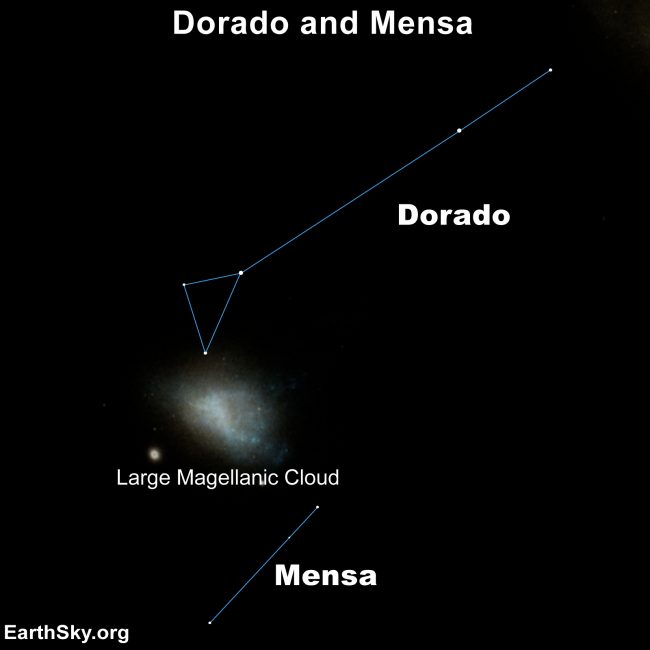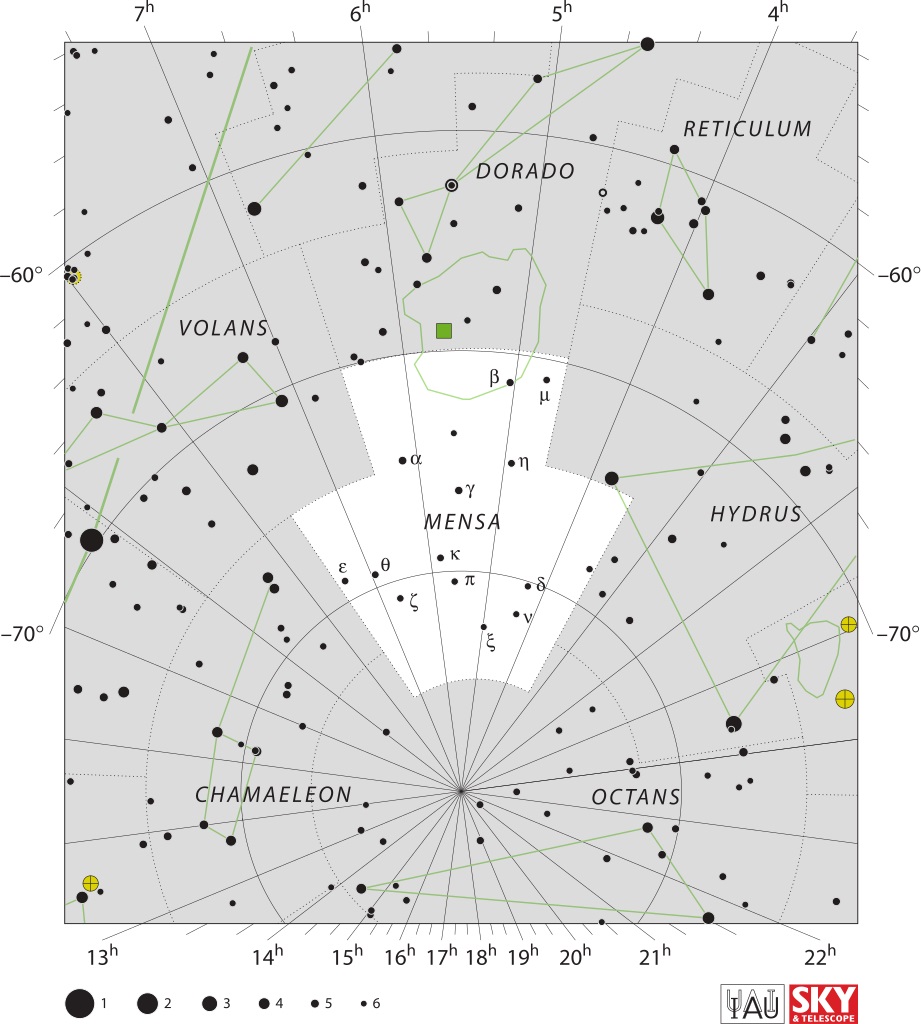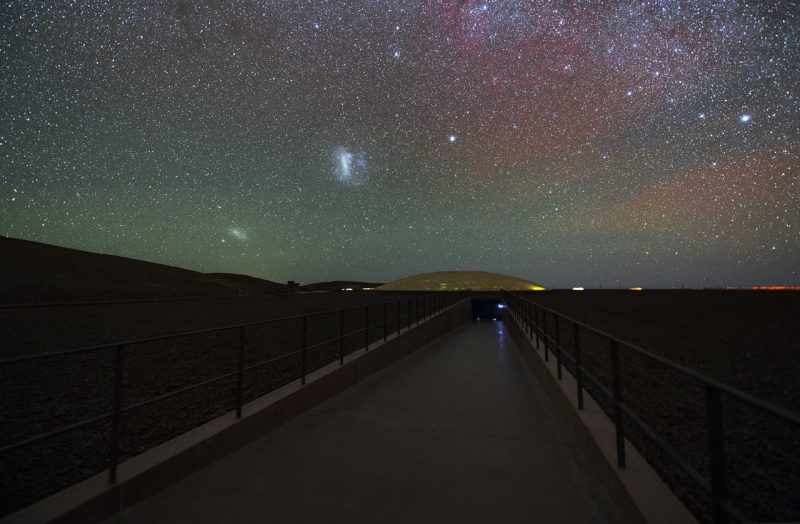
South circumpolar constellations are those that can be seen any time of year for observers in the Southern Hemisphere. Dorado the Swordfish and Mensa the Table Mountain are two of these. They hold the important distinction of being home to the Large Magellanic Cloud, a satellite galaxy of the Milky Way, which flows across the border from one constellation to the other.
The constellation Dorado the Swordfish
Dorado is a constellation in Southern Hemisphere skies that variously has the nickname of Swordfish, Dolphinfish and Goldfish. The two brightest stars of Dorado are actually somewhat dim. Alpha Doradus is magnitude 3.30, and Beta Doradus is magnitude 3.76. Still, you should be able to see these stars from a city without too much light pollution.
You’ll definitely want a dark sky, however, when it’s time to spot the most important feature of Dorado: the Large Magellanic Cloud. Dorado holds the larger portion of this satellite galaxy that it shares with Mensa. While you can see the Large Magellanic Cloud without optical aid, a telescope will let you explore many more of its clusters and nebulae.
Inside the Large Magellanic Cloud on Dorado’s side of the border is a popular nebula: the Tarantula Nebula, NGC 2070. The Tarantula Nebula shines at magnitude 8.19. It’s remarkable that we can see this cloud of gas and dust from another galaxy that’s around 160,000 light-years away. It’s the largest known nebula where new stars are being born. The Tarantula Nebula is an emission nebula, the same type of nebula as the Orion Nebula, M42. If the Tarantula Nebula were the same distance from Earth as the Orion Nebula, it would appear as large as the entire constellation of Orion.

The constellation Mensa the Table Mountain
French astronomer Nicolas-Louis de Lacaille named Mensa the Table Mountain for Table Mountain in South Africa. Dorado borders Mensa on one side, and Octans – the constellation that contains the South Celestial Pole – lies on its opposite side.
Mensa’s stars are so dim that its “brightest” is the magnitude 5.1 star Alpha Mensae. In fact, no other constellation has a dimmer “brightest” star than Mensa. So of all the 88 constellations, Mensa could be considered the dimmest.
Even though Mensa contains nearly half of the Large Magellanic Cloud, most of the constellation’s star clusters, both open and globular, are rather dim. One unusual star, a luminous blue variable that scientists named R71, is normally an 11th magnitude star except during outbursts. In the 1970s it had regular outbursts, raising its magnitude temporarily to 9.2. Then, in 2012, it brightened to more than a million times as luminous as the sun. But even then, with its great distance, its peak magnitude was just 8.7, which you’d still have needed a telescope to see. Faintness is Mensa’s claim to fame.

The Large Magellanic Cloud
The Large Magellanic Cloud lies in both the constellations Dorado and Mensa. Draw a line from Sirius past the right side of Canopus to find it.
The Large Magellanic Cloud shines at magnitude 0.9. Keep in mind that it’s stretched out over an area of sky about 9 by 11 degrees. A star of that magnitude would appear very bright because of its pinpoint source of light, but for the Large Magellanic Cloud, its diffuse, spread-out light means it appears as a hazy smudge on the sky.
The famous Supernova 1987A exploded in the Large Magellanic Cloud, on the Dorado side of the border. After it lit up overnight from February 23 to 24, 1987, people continued to see the supernova with the unaided eye for months. In fact, it didn’t peak in brightness until May. It was the brightest supernova visible in 400 years.

Bottom line: The constellations Mensa and Dorado are deep in southern skies. Between them, stretching across the border, lies the Large Magellanic Cloud.
The post Dorado and Mensa house the Large Magellanic Cloud first appeared on EarthSky.
from EarthSky https://ift.tt/3tC5Gpj

South circumpolar constellations are those that can be seen any time of year for observers in the Southern Hemisphere. Dorado the Swordfish and Mensa the Table Mountain are two of these. They hold the important distinction of being home to the Large Magellanic Cloud, a satellite galaxy of the Milky Way, which flows across the border from one constellation to the other.
The constellation Dorado the Swordfish
Dorado is a constellation in Southern Hemisphere skies that variously has the nickname of Swordfish, Dolphinfish and Goldfish. The two brightest stars of Dorado are actually somewhat dim. Alpha Doradus is magnitude 3.30, and Beta Doradus is magnitude 3.76. Still, you should be able to see these stars from a city without too much light pollution.
You’ll definitely want a dark sky, however, when it’s time to spot the most important feature of Dorado: the Large Magellanic Cloud. Dorado holds the larger portion of this satellite galaxy that it shares with Mensa. While you can see the Large Magellanic Cloud without optical aid, a telescope will let you explore many more of its clusters and nebulae.
Inside the Large Magellanic Cloud on Dorado’s side of the border is a popular nebula: the Tarantula Nebula, NGC 2070. The Tarantula Nebula shines at magnitude 8.19. It’s remarkable that we can see this cloud of gas and dust from another galaxy that’s around 160,000 light-years away. It’s the largest known nebula where new stars are being born. The Tarantula Nebula is an emission nebula, the same type of nebula as the Orion Nebula, M42. If the Tarantula Nebula were the same distance from Earth as the Orion Nebula, it would appear as large as the entire constellation of Orion.

The constellation Mensa the Table Mountain
French astronomer Nicolas-Louis de Lacaille named Mensa the Table Mountain for Table Mountain in South Africa. Dorado borders Mensa on one side, and Octans – the constellation that contains the South Celestial Pole – lies on its opposite side.
Mensa’s stars are so dim that its “brightest” is the magnitude 5.1 star Alpha Mensae. In fact, no other constellation has a dimmer “brightest” star than Mensa. So of all the 88 constellations, Mensa could be considered the dimmest.
Even though Mensa contains nearly half of the Large Magellanic Cloud, most of the constellation’s star clusters, both open and globular, are rather dim. One unusual star, a luminous blue variable that scientists named R71, is normally an 11th magnitude star except during outbursts. In the 1970s it had regular outbursts, raising its magnitude temporarily to 9.2. Then, in 2012, it brightened to more than a million times as luminous as the sun. But even then, with its great distance, its peak magnitude was just 8.7, which you’d still have needed a telescope to see. Faintness is Mensa’s claim to fame.

The Large Magellanic Cloud
The Large Magellanic Cloud lies in both the constellations Dorado and Mensa. Draw a line from Sirius past the right side of Canopus to find it.
The Large Magellanic Cloud shines at magnitude 0.9. Keep in mind that it’s stretched out over an area of sky about 9 by 11 degrees. A star of that magnitude would appear very bright because of its pinpoint source of light, but for the Large Magellanic Cloud, its diffuse, spread-out light means it appears as a hazy smudge on the sky.
The famous Supernova 1987A exploded in the Large Magellanic Cloud, on the Dorado side of the border. After it lit up overnight from February 23 to 24, 1987, people continued to see the supernova with the unaided eye for months. In fact, it didn’t peak in brightness until May. It was the brightest supernova visible in 400 years.

Bottom line: The constellations Mensa and Dorado are deep in southern skies. Between them, stretching across the border, lies the Large Magellanic Cloud.
The post Dorado and Mensa house the Large Magellanic Cloud first appeared on EarthSky.
from EarthSky https://ift.tt/3tC5Gpj

Aucun commentaire:
Enregistrer un commentaire